- Introduction
- Stretching Techniques
- Benefits of Flexibility Training
- Ballistic Stretching
- PNF Stretching
- Static Stretching
- Use of Static Stretching
- When and Where to Stretch
- The Do's and Don't of proper Stretching
- Stretching During Pregnancy
- What Happens to Muscles and Tendons During a Stretch ?
- Always Warm-Up Before Stretching
- Stretch Before and After Exercise
- Stretch Between Weightlifting Sets
- Stretch Before and After Cardiovascular Exercise
- Importance of Combining Strength Training, Cardiovascular Exercise, and Good Nutrition with Your Flexibility Training Program
- Staying Motivated
- Factors Affecting Flexibility
- Take Action
WF flexibility training component is your on-line "how to"
manual. Everything you need to know about flexibility training and
exactly how to achieve the results you desire, is taught in this
manual.
The flexibility training component is 16 pages long and can be viewed on your computer or printed out. All the examples in this content are linked to demonstrations that will enhance your understanding.
Below is a list of all the very important topics we'll discuss throughout the flexibility training components.
In the flexibility training component, you will find information on:
- The benefits of flexibility training
- The three basic stretching techniques
- Principles and guidelines for:
- Using static stretching to achieve maximum results
- The importance of warming-up before stretching
- Stretching before and after exercise
- The importance of stretching between weightlifting sets
- How and when to include stretching in your strength training program without
taking up more time
- How and when to include stretching in your cardiovascular exercise program for
maximum results
- How to combine strength training, cardiovascular exercise, and good nutrition
into your flexibility training program
- Ways to stay motivated
- The factors that affect your flexibility
- All the examples in this content are linked to demonstrations that will enhance your understanding.
Introduction
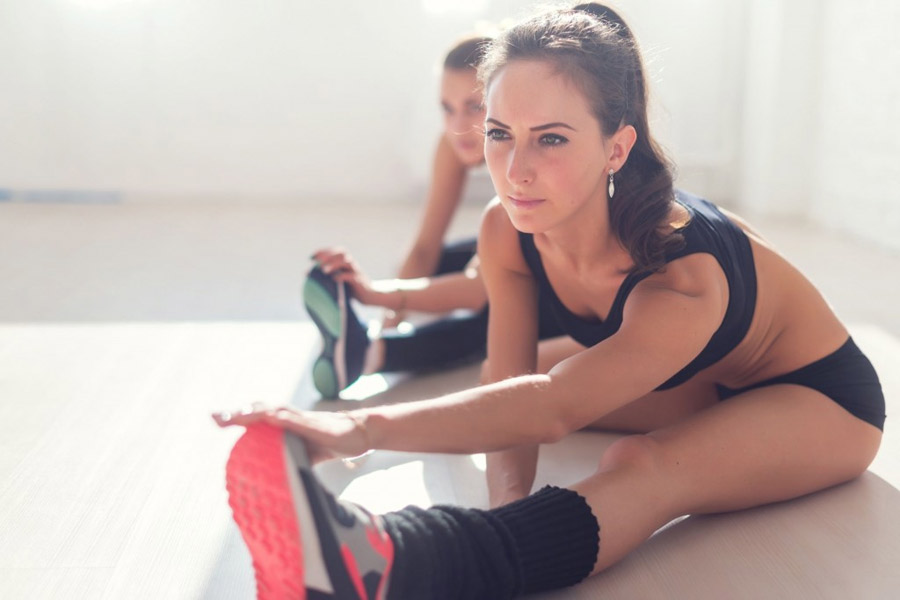
The
flexibility Training component will teach you the three basic
stretching techniques and the very important principles and
guidelines of a safe, effective flexibility-training program.
You'll learn exactly how to get the best results, including when
to stretch, how often to stretch, and how long to hold the stretch
for maximum benefits. In addition, you'll learn how to include
stretching with your cardiovascular exercise and strength-training
programs, without taking up much of your valuable time. We also
discuss ways of staying motivated throughout your program. Lastly,
we'll discuss the factors that affect flexibility.
Warming up and cooling down should be an integral part of any type
of exercise or sport, particularly aerobics, for its dangerous and
in efficient to leap immediately from rest to maximum activity.
When you are at rest, your blood circulates more or loss evenly
through the body, facilitating the healthy functioning of all
vital organs. When a specific part of the body is called into
action a greater blood supply carrying oxygen is sent to the
working parts.
Warm up and stretching is essential to signal your body that a
certain group of muscles will be in need of increased supply of
oxygen.
Benefits of Flexibility Training
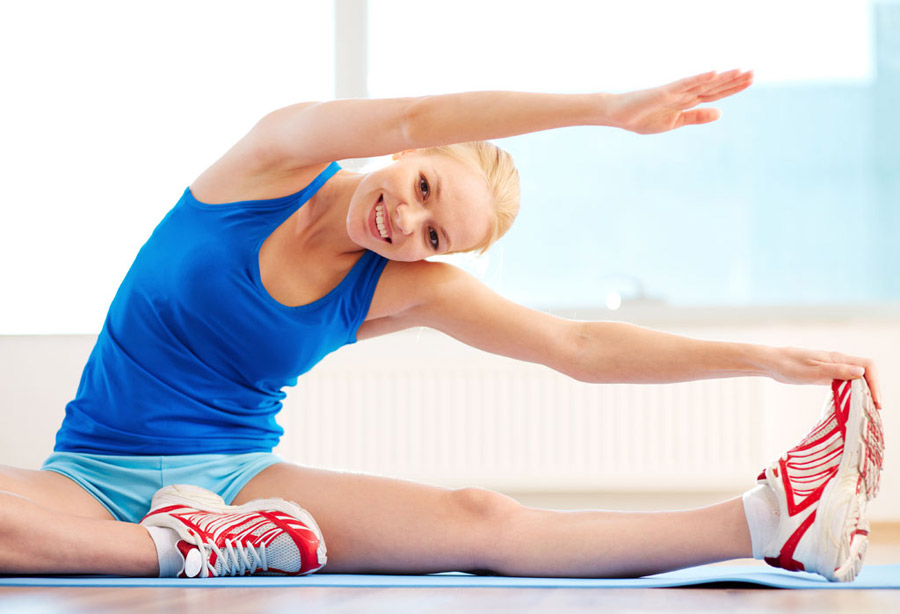
Flexibility
is a joint's ability to move through a full range of motion.
Flexibility training (stretching) helps balance muscle groups that
might be overused during exercise or physical activity or as a
result of bad posture. It's important to clearly understand the
many benefits that result from a good flexibility program.
Improved Physical Performance and Decreased Risk of Injury
First, a safe and effective flexibility training program increases
physical performance. A flexible joint has the ability to move
through a greater range of motion and requires less energy to do
so, while greatly decreasing your risk of injury. Most
professionals agree that stretching decreases resistance in tissue
structures; you are, therefore, less likely to become injured by
exceeding tissue extensibility (maximum range of tissues) during
activity.
Reduced Muscle Soreness and Improved Posture
Stretching reduces muscle soreness , refer to the Strength
Training content ahead . Recent studies show that slow, static
stretching (explained in the next section) helps reduce muscle
soreness after exercise. Moreover, stretching improves muscular
balance and posture. Many women's soft-tissue structures had
adapted poorly to either the effect of gravity or poor postural
habits. Stretching can help realign soft tissue structures, thus
reducing the effort it takes to achieve and maintain good posture
in the activities of daily living.
Reduced Risk of Low Back Pain
A key benefit, and one we wish more women would realize, is that
stretching reduces the risk of low back pain.
Stretching promotes muscular relaxation. A muscle in constant
contraction requires more energy to accomplish activities.
Flexibility in the hamstrings, hip flexors, quadriceps, and other
muscles attaching to the pelvis reduces stress to the low back.
Stretching causes muscular relaxation, which encourages healthy
nutrition directly to muscles; the resulting reduction in
accumulated toxins reduces the potential for muscle shortening or
tightening and thus reduces fatigue.
Increased Blood and Nutrients to Tissues
Another great benefit is that stretching increases blood supply
and nutrients to joint structures. Stretching increases tissue
temperature, which in turn increases circulation and nutrient
transport. This allows greater elasticity of surrounding tissues
and increases performance. Stretching also increases joint
synovial fluid, which is a lubricating fluid that promotes the
transport of more nutrients to the joints' articular cartilage.
This allows a greater range of motion and reduces joint
degeneration.
Improved Muscle Coordination
Another little-known benefit is increased neuromuscular
coordination. Studies show that nerve-impulse velocity (the time
it takes an impulse to travel to the brain and back) is improved
with stretching. This helps opposing muscle groups work in more
synergistic, coordinated fashion.
Enhanced Enjoyment of Physical Activities
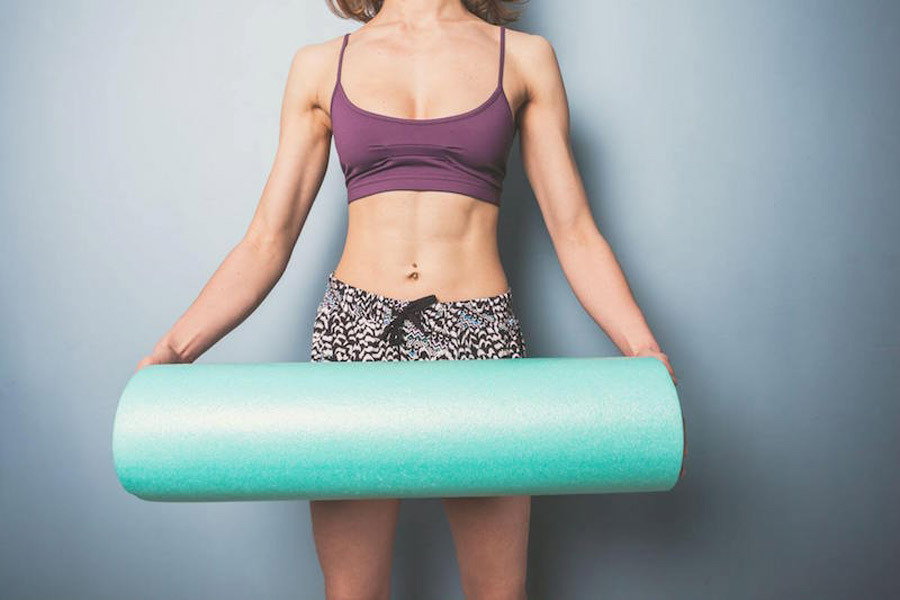
Flexibility training also means enhanced enjoyment, and a fitness program should be fun if you want to stick with it. Not only does stretching decrease muscle soreness and increase performance; it also helps relax both mind and body and brings a heightened sense of well being and personal gratification during exercise.
You are now ready for the Flexibility Training component. We begin with the stretching techniques, and then proceed to the principles and guidelines of an effective flexibility-training program. We will then discuss the best ways to stay motivated and the factors that effect flexibility.
Three basic techniques are used to increase flexibility: ballistic stretching, pro-prioceptive neuromuscular facilitation (PNF) and static stretching.
Stretching Techniques
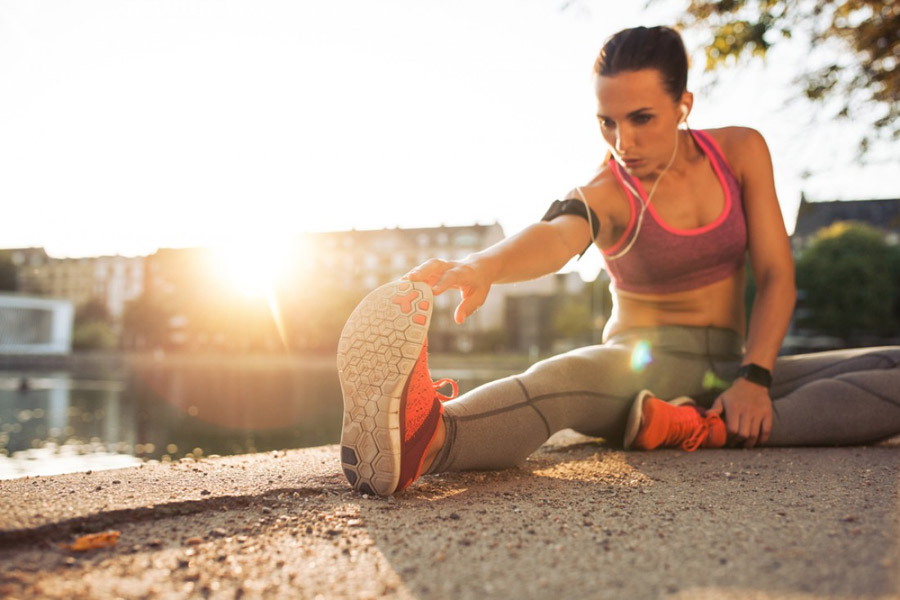
Three
basic techniques are used to increase flexibility: ballistic stretching,
pro-prioceptive neuromuscular facilitation (PNF) and static stretching.
Ballistic Stretching
Ballistic stretching is often called dynamic stretching and employs
rapid, bouncing motion. This method may promote dynamic flexibility and
decrease potential injury by preparing tissues for high speed and free
moving activity. Generally used by those training for competitive sports.
When you bounce , your muscle stretch suddenly and violently like a rubberband
being yanked (when you do that to rubber band it can break) due to
this reason it was banned from the fitness industry in 1980's.
PNF Stretching
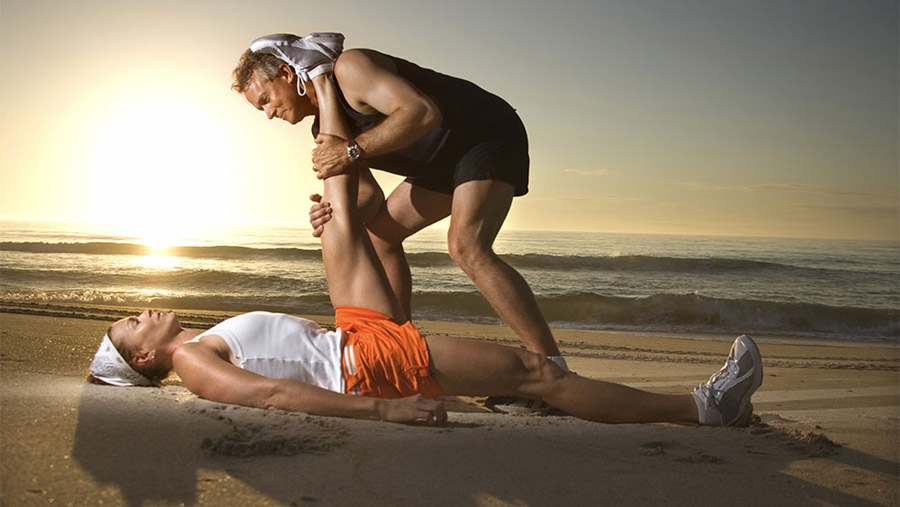
The second form of stretching, PNF was developed by physical therapists for use in rehabilitation. This technique is to be done with a partner who is a knowledgeable professional. Some fitness instructors teach simple PNF stretches in classes . PNF or Proprioceptive Neuromuscular Facilitation is a fancy term for tensing and then relaxing the muscles . Theoretically , fatiguing a muscle before stretching it will tire the muscle out so it will be more willing to slide into deeper stretches . Remember , PNF is a fairly complicated venture , best overseen by a therapist and not recommended for anyone with high blood pressure or coronary heart disease . It might be uncomfortable for some women , since not everyone enjoys the tensing part of the exercise .
Static Stretching
A
static stretch involves a slow, gradual, and controlled elongation of the
muscle through a full range of motion that should be held in the furthest
comfortable position for 15-30 sec. Static stretching helps prevent the
muscle soreness that accompanies a strength training program.
Low-intensity, long duration stretch produces a lot less micro-trauma and
strain. It is vital and essential part of the balanced training program,
whether you are an athlete or exercise for health. It is the most
beneficial method of stretching, you don't need a trained professional
and it is by for the safest. You shouldn't work hard to increase your
flexibility , but rather you should" surrender" into it .
Use of Static Stretching
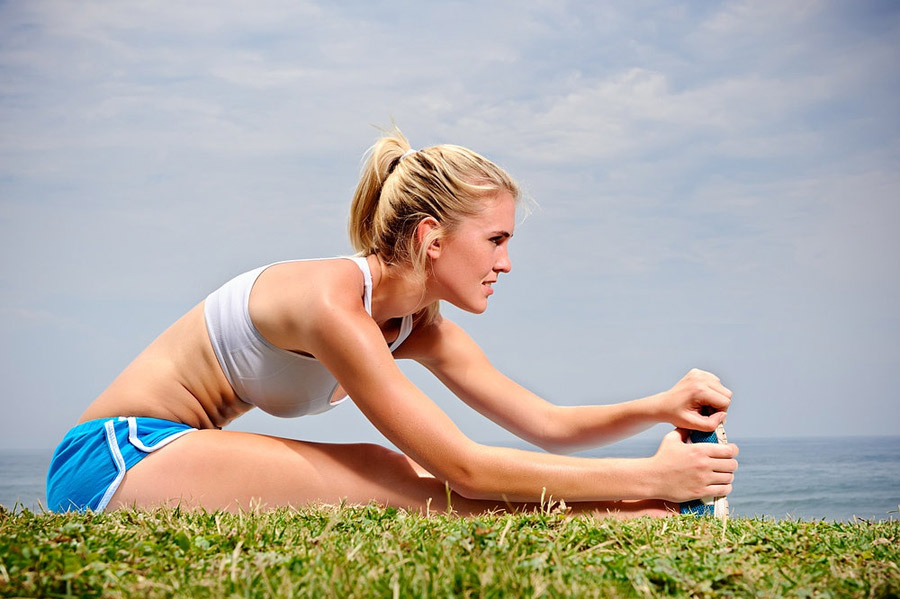
Static stretching involves a slow, gradual and controlled elongation of the muscle through the full range of motion and held for 15-30 seconds in the furthest comfortable position (without pain) this is the first and most important stretching principle. In our opinion, all stretches for each muscle group should be done by using this static form of stretching.
Stretching is best, during and after exercise session. Frequent stretching will help you avoid muscular imbalance, knots and tightness and muscle soreness created by daily activities and exercise.
The period after exercise is even more
important. If you stop exercising suddenly, the body can suffer shock and
the muscle tends to shorten, with subsequent stiffness and loss of
flexibility. First reduce the exercise you are doing to a slow pace, then
use knee and hip flex, hip shifts, knee lunges and ankle circles. They give the important muscle groups a mild stretch.
When and Where to Stretch
A muscle can only be stretched safely when it is warm. You can run for a couple of minutes to work up sweat and then stretch.
The best place to stretch is on a towel or mat indoors-or on a
flat, open stretch of grass outside. Bare feet are better for balance and
stability so consider taking off your shoes.
The Do's and Don't of proper Stretching

There are two wrong ways to do it:
- Passive stretching is practiced by those who think that just hanging out in a given position, waiting for gravity to do their work for them will stretch the muscles and develop greater flexibility. Usually these women are preoccupied with thinking of the daily errands and only half aware of what they are doing.
- "Aggressive Stretching" involves bend; force and bounce to reach into the deserved position with gritted teeth clenched fists and gnarled foreheads. They rip away at both ends of a cold muscle and can injure themselves - weakening and tearing muscles while attaining no flexibility.
- The right kind of stretching or "Active stretching" involves total concentration and hard work. It requires patience, practice and perseverance - the ability to stick with a certain posture until you achieve a greater range of motion.
- Never stretch a cold muscle, always warm-up first to get blood circulating throughout the body and into the muscle. It should be a slow rhythmic exercise of larger muscle group done before an activity. The warm up should last 5-10 min and should be similar to activity that you are about to do, but at a much lower intensity./li>
- Correct deep breathing aids concentration, smoothness, relaxes muscles, and increases energy enabling you to get the most from every mile. You must practice belly breathing using your total lung capacity, inhaling fully and deeply down to the abdomen several times before you begin your stretching. It is more efficient than three to four upper chest pants.
- Along with the slow warm-up movements add movements that will ease and lubricate the joints into action.
-
Both strength training and flexibility training are
important to everyone. Those who have a hard time finding time
to incorporate a strength training program into their lifestyles, can combine stretching with strength training program. - Remember to move gently at all times and never strain. Never bounce or jerk yourself into position ,never "collapse" out of a stretching "Pose". We all have different areas of tightness and different problems of flexibility so don't expect to be equally proficient in all the postures. Adapt or modify these exercises, necessary to suit your level of ability and training needs.
Your greatest challenge, however, is not learning new stretching exercises or the proper techniques, it not learning how long to hold the stretch or the best time to stretch. Nor is it deciding when to try new stretching exercises. The greatest challenge facing you at this moment is deciding whether you are willing to take action and make time for yourself and make flexibility training a priority.
When you begin achieving great results, the excitement and feel you experience will make the change well worth the effort.
Stretching During Pregnancy
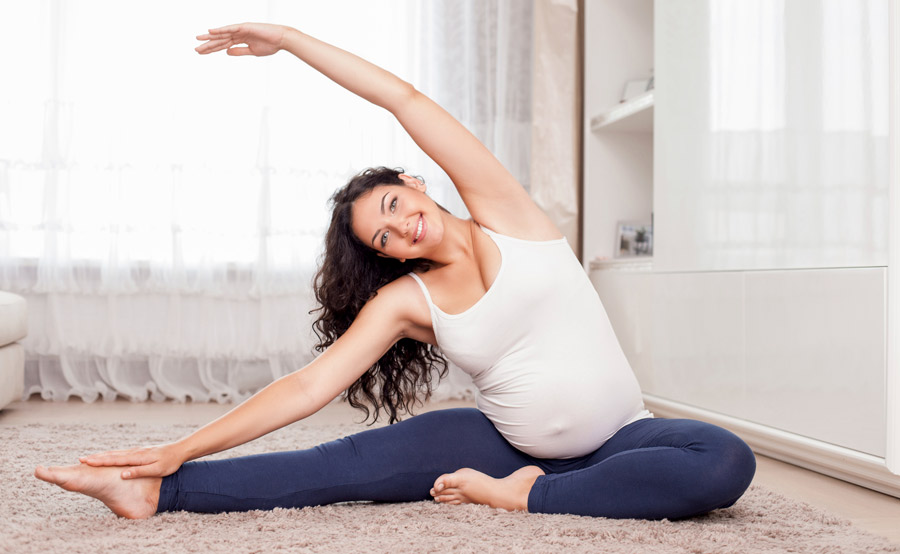
Thanks to a hormone called relaxin, pregnant women usually become more flexible than they were before they got pregnant. It seems that mother nature has virtually "wired" women to stretch during this time. All this flexibility serves two purposes for pregnancy and childbirth; normally, when a muscle or organ is stretched as far as the uterus must stretch, it cramps, if this were to happen to the uterus, the pregnancy would terminate. Relaxin prevents this. Relaxin also softens the connective tissue in the pelvis to widen the birth canal.
Stretching is a wonderful form of exercise to do through pregnancy and beyond. It can case all sorts of physical land mental discomforts: help a woman adjust to her body's shifting center of gravity, give her energy, and erase some of the stresses and fears associated with pending motherhood. It can also speed her recovery childbirth.
If you are pregnant, you should approach stretching as you would any form of exercise. It is ideal to get in shape before you get pregnant; once you are pregnant, do your physical activities not
to "get in shape" or keep your weight gain down but to maintain the highest level of health and safety for you and your baby. This isn't a time to try a new sport or break new records. You're better off maintaining your
pre-pregnancy activities, tapering off as your body dictates. Of course, you should avoid activities like skating or soccer where you could fall or get hit; instead choose "minimal-impact" exercise that you enjoy and feels relatively easy to do.
Before you begin my exercise program, including stretching, be sure to get your doctor's permission. Get it again after delivery, resuming your workouts, especially if you have had a cesarean section.
Some other important things you should know about pregnancy and exercise;
Don't Get Overheated
Don't sit or stretch in a whirlpool, sauna, or steam room. When doing aerobic exercise, avoid working at too high a heart rate (this avoids overheating and overexerting). Use the following heart-rate guidelines for your age group: under 20 : 140-55; 20-29: 135-50; 30-39: 130-45; and over 40: 125-40
Drink More Water Than You Think Need
Dehydration can cause an early labor. Drink water before, during, and after exercise - Even a
stretching workout. Once you're thirsty, you're already somewhat dehydrated.
Eat Every Few Hours, Even If You Don'T Feel Like It And Even If It'S Just A Snack
When you're pregnant, you consume three hundred more calories per day than before. Add exercise, and you'll need even more. Several small meals throughout the day can keep your energy up and will nourish your baby.
Stop Exercising Immediately And Call Your Doctor If You Experience Any Pain, Bleeding, Contractions, Dizziness, Nausea, Or Numbness.
Don't Lie On Your Back For Long, Especially After The First Trimester
This position reduces blood flow to the uterus. The best postures for exercise and
stretching while pregnant are standing, seated upright, or supported, forward-leaning stretches, either standing or on your hands and knees.
Be Mindful Of Your Wrists
Your extremities usually swell during pregnancy. This can affect the nerves in your wrists and cause carpal tunnel syndrome. Avoid putting excessive weight on your wrists (especially during stretches on your hands and knees) if this causes pain.
What Happens
to Muscles and Tendons During a Stretch
?
Muscles contain sensitive "stretch receptors", which tell the nervous system if the body is tight or relaxed- and the nervous system reacts accordingly (stimulating the release of adrenaline when we're stressed or more pleasurable neurotransmitters like serotonin or endorphins when we're feeling good). All of this happens on a cellular level. There are two types of sensory receptors, the muscle spindle and the Golgi tendon organ. The muscle spindle exists inside the muscle and basically determines the extent to which the muscle is going to stretch or contract (based on how much force is being exerted against it). The golgi tendon organ sits in the space where the muscles meet the tendons and oversees the
stretching ability of the muscles and tendons. (These stretch receptors also rush in like good soldiers to protect the muscles and tendons with the "stretch reflex" when a stretch becomes too sudden or violent.)
Always Warm-Up Before Stretching

A warm muscle is much more easily stretched than a cold muscle. Never stretch a cold muscle, always warm-up first to get blood circulating throughout the body and into the muscles. A warm-up should be a slow, rhythmic exercise of larger muscle groups done before an activity. Riding a bicycle or walking works well. This provides the body with a period of adjustment between rest and the activity. The warm-up should last about 5-10 minutes and should be similar to the activity that you are about to do, but at a much lower intensity. Once you have warmed up at a low intensity for about 5-10 minutes and have gotten your muscles warm, you can now stretch.
Stretch Before and After Exercise
WF recommends stretching both before and after exercise, each for different reasons. Stretching before an activity (after the warm-up) improves dynamic flexibility and reduces the chance of injury. Stretching after exercise ensures muscle relaxation, facilitating normal resting length, circulation to joint and tissue structures, and removal of unwanted waste products, thus reducing muscle soreness and stiffness. Body temperature is highest right after the cardiovascular exercise program and/or after strength training. In order to achieve maximum results in range of motion and to receive other benefits, it is highly recommended that you do static stretching at this point in your workout, just after your cardiovascular program and during or after your strength-training program.
Stretch Between Weightlifting Sets
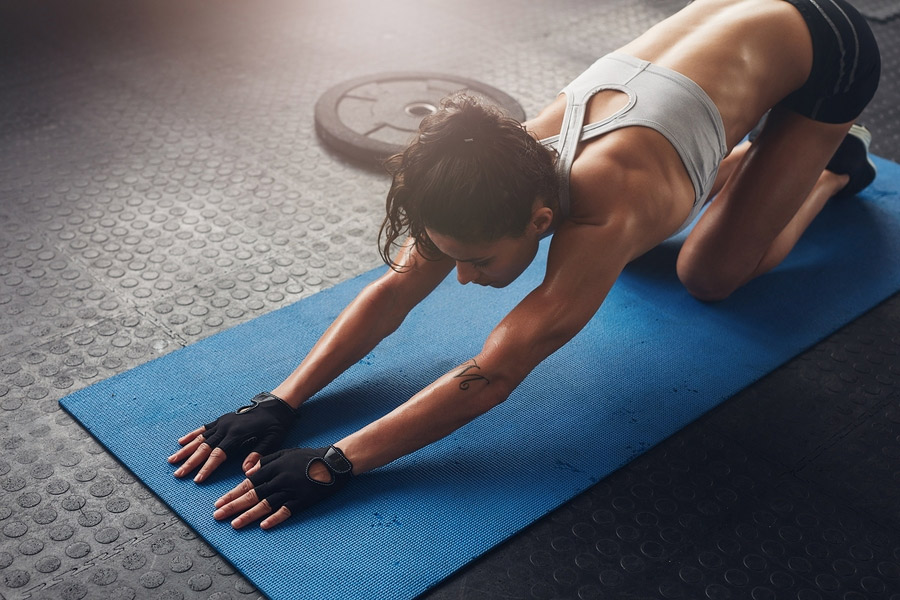
Both strength training and flexibility training are so important for
every women . Those of you who have a hard time finding time to incorporate a strength training program into your lifestyle, can combine your stretching with your strength training programs. If you have had any experience in strength training, you know that for each exercise for each muscle group you train, you have a certain number of sets, usually between one and four. Between each set, you need to rest and let your muscle recover before going on to the next set. Well, what better use of your resting time than to stretch that specific muscle that you're currently training? Think about it, you've just done a set of 10 reps on the Bench Press (Bb) (Ex. #S31). Now you have to rest, usually about one to two minutes before doing the next set. This is a great time to stretch your chest-- your chest is warm and you have time before you start your next set.
How often do you see women who neglect to warm up before their cardiovascular exercise or strength-training sessions? They begin going through their stretching routine before their muscles are even warm. It makes more sense to stretch each specific muscle between sets of strength training exercises. For example, if you are on a strength-training program where you do one exercise of three sets of 10 reps for each major muscle group in the body, you will want to work each muscle group one at a time starting with larger muscle groups and proceeding to smaller groups (Refer to the WF Strength Training content). Do your first set with relatively light weight to warm-up, then rest for a minute or so and then increase the weight and go onto the next set of 10 reps (or whatever your goal reps happens to be). After the second set, your muscles should be warm and ready to be stretched. While resting before your third set, stretch the muscle that you have just trained, remembering the important principles of a static stretch, then proceed to your third and final set. Stretch the muscle one more time, even a little further. Go on to the next exercise for the next muscle group and after it is warm, do your stretch for that muscle, and so on. When you have gone through each of your strength-training exercises, you will have stretched each muscle without taking-up any more time.
Stretch Before and After Cardiovascular Exercise
If it is your day off from strength training and you are just doing your cardiovascular exercise routine, first warm-up for 5-10 minutes at a low intensity (50-60 percent of your maximum heart rate ) and stretch the muscles used. Proceed doing a cardiovascular exercise for at least 20 minutes at a intensity of 50-85 percent of your maximum heart rate (refer to the WF Cardiovascular Exercise content). Then cool down for 5-10 minutes at a low intensity (50-60 percent of your maximum heart rate). Now, because your muscles are very warm you should stretch each of the major muscle groups involved in the exercise, using the static stretching techniques we explained previously. For example, if you walked on the treadmill, you should stretch your quadriceps (#F13), hamstrings (# F17), calves (#F19), and lower back (# F5/6). Proper technique for each stretch is absolutely critical for achieving maximum effectiveness in any one specific muscle group. In addition to stretching those muscles used in the exercise, now is also a good time to go through a full body stretching routine--since blood has circulated throughout your body and warmed-up your muscles.
Importance of Combining Strength Training, Cardiovascular Exercise, and Good Nutrition with Your Flexibility Training Program
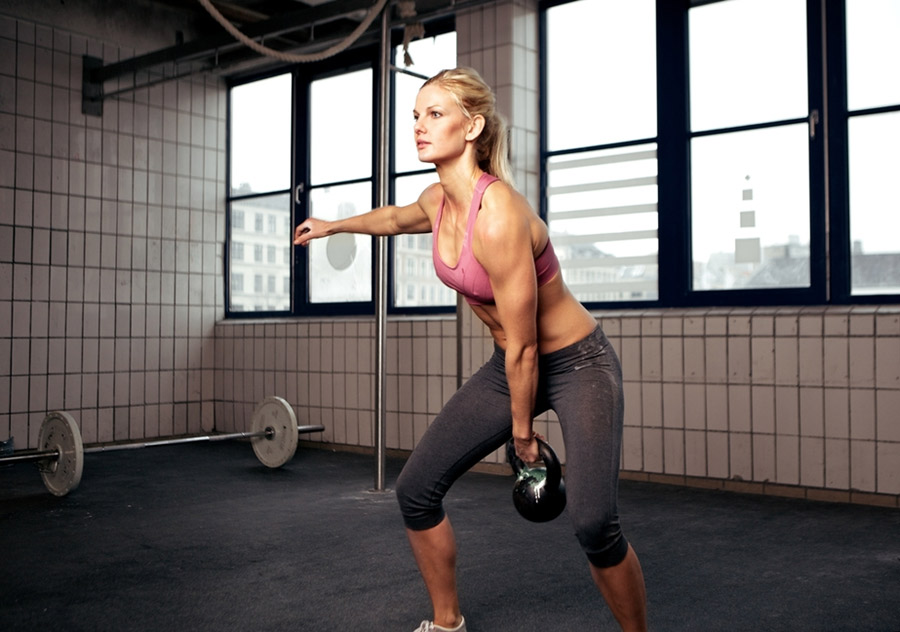
By now you have probably realized that flexibility training should be an important part of your exercise routine. Flexibility training provides many important benefits that cannot be achieved by any other exercise or activity. In addition to flexibility training, there are four other important components of overall health and fitness: strength training, cardiovascular exercise, and proper nutrition/weight management.
Implementing all five components of health and fitness may seem overwhelming at first, but making small simple changes over time in each of these areas will drastically improve how you think, look, act and feel. In addition, improving any one of the five components of health will complement and thereby make improvements in other aspects of your health. For example, flexibility training will not only decrease your risk injury and reduce soreness and pain, it will also make improvements in your weightlifting performance.
Note: Please refer to each specific component for further detailed information on each of the other four aspects of health and fitness.
Strength Training
Strength training is exercise that uses resistance--for example, weights-to strengthen and condition the musculo-skeletal system, improving muscle tone and endurance. Physiologically, the benefits of consistent strength training include an increase in muscle size and tone, increased muscle strength, and increases in tendon, bone, and ligament strength. Strength training has also been shown to improve psychological health as well, by increasing self-esteem, confidence and self-worth. These improvements have a great influence on our physical performance, metabolic efficiency, physical appearance and risk of injury.
One of the biggest mistakes women make when starting an exercise and nutrition/weight management program is not including a strength-training program with their
cardiovascular exercise and low-fat eating regimen. This is unfortunate because when we cut calories without exercise, we can lose muscle as well as fat. Many do not choose to do strength training because
1) they mistakenly think they are going to make their body big and bulky, and
2) they do not realize how beneficial and important strength training is in a weight-management program. Please refer to the WF Strength Training content to learn the most effective ways to achieve the results you want and deserve.
Cardiovascular Exercise
As you will learn, it's important to train all your muscles. But many women miss the one muscle that is perhaps the most important to the body: the heart. It is very important that your heart and lungs be trained so they can help you fight the many health problems associated with heart disease. And there's a bonus: you will rev your metabolism and burn fat in the process. Weightlifting may get your heart beating faster and make your breathing heavy, but it does not get your heart rate up to the consistent, higher training level that is so important for keeping your cardiovascular system healthy.
Building your cardiovascular system is a lot like building any other muscle or muscle group. The exercises that improve your heart's ability to pump blood and your lungs' ability to provide oxygen are what we call cardiovascular exercises, like fast walking, jogging, cycling, swimming, or using the rowing machine or stairstepper. Sports such as basketball, soccer, hiking, and tennis are also considered cardiovascular in nature.
Cardiovascular exercise is any repetitious activity that elevates and keeps your heart rate at 50-100 percent of its maximum. You should do some form of cardiovascular exercise at least three times a week, for at least 20 minutes per session, at intensities of 55-85 percent of your maximum heart rate. Although strength training programs need at least one day of rest between training specific muscle groups, cardiovascular workouts, like stretching, can be done on both your strength-training days and your days off.
This form of exercise usually does not cause micro trauma or any temporary damage (good) to muscles, like strength training does, so we encourage you to train cardiovascularly at least three to five days a week. Before doing this, we strongly recommend reviewing the WF Cardiovascular Exercise content for important principles, guidelines, and safety precautions. Remember, strong muscles are worthless if your heart and lungs are not powerful enough to let you use those muscles.
Nutrition/Weight Management
The average American adult's diet is about 35 percent fat, 45 percent carbohydrates, and 20 percent protein. As you probably already know, you should try to decrease your fat intake to no more than 30 percent of your total calories. In fact, for good health you should try to consume less than 25 percent fat; less than 10 percent saturated fat, and 20 percent protein. If you are like most women, you are probably convinced that you need more protein in your diet. Yes, your body does need protein to build muscle, but women who eat a well-balanced diet generally consume all the protein they need to build muscle or increase strength.
What you do need to increase, , is your carbohydrate intake--to about 60 percent. At least 50-55 percent should be of the complex kind and less than 10 percent should be simple carbohydrates or sugars. During exercise, your muscles are powered by a substance called glycogen, which your body makes from carbohydrates. Refer to both the WF Nutrition and the Weight Management contents for further details of each of these nutrients, their RDA, and the food sources that are rich in each one. You will also find information on the importance of vitamins, minerals and water.
Staying Motivated

One way to stay motivated is to constantly remind yourself that a worth-while pay-off lies ahead; a new, healthy, flexible you is emerging. You will not only improve your overall health and fitness, but will also improve your appearance, energy level, and social interactions. Also, look forward to the many psychological benefits as well: confidence, self-esteem, and relief from depression, anxiety and stress.
If you are serious about your health and well-being, you will take action and implement these training principles and guidelines, and you will benefit in all these ways. Once you see the results, you will become even more motivated. Action creates motivation!
Set Goals
Goal-setting is another great way of staying motivated. Goals focus your workout . Giving you a direction to move .
Factors Affecting Flexibility
Several factors, other than your training technique, are specific to each person and contribute to flexibility and the success of any fitness program.
Age
Studies show a distinct relationship between age and how flexible someone is. The greatest increase in flexibility usually occurs between the ages of 6 and 12. Flexibility tends to level off during early adolescence and then slowly declines after age 25. Normal aging tends to cause significant changes in connective tissues and eventually decreases extensibility. Aging increases both the diameter of collagen fibers and strengthens connective tissues, which increases the resistance to deformation.
Level of Activity
How active a women is also affects flexibility. Generally speaking, the more active the women, the more flexible she will be. Inactivity permits shortening of the connective tissues. When connective tissue are not regularly stretched, they become shorter and less resilient, making it difficult to obtain the good muscular balance essential for proper alignment during activity. Regular stretching enhances tissue adaptability and decreases wear and tear.
Gender
Although evidence is still lacking regarding the differences between gender and flexibility, females are generally much more flexible than males. One reason might be that women are designed for a greater range of flexibility, especially in the pelvic region, for childbirth.
As you can see, flexibility is highly specific to individuals, their daily activities, and their age and gender. Flexibility is an essential component of physical fitness and since each women has different musculature, joint structure, genetic composition, and activity level. It is important that you develop a flexibility training program that is right for you.
Take Action
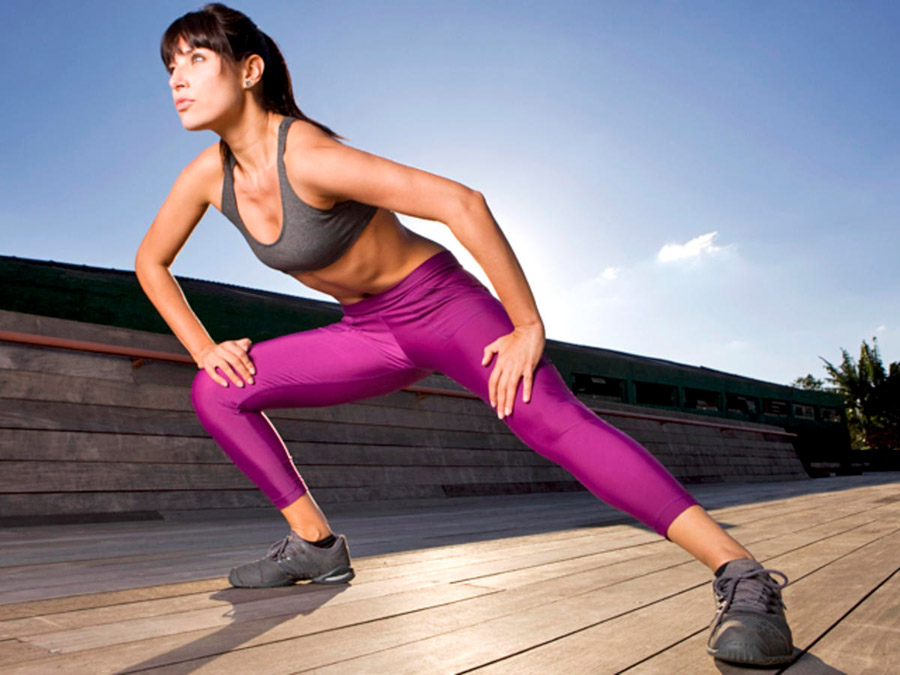
We hope you have found the information in this component helpful. You now have the knowledge and the tools ( demonstrations and exercise instructions) to achieve the results you desire and the benefits your body deserves. Your greatest challenge, however, is not learning new stretching exercises or the proper technique; it's not learning how long to hold the stretch or the best time to stretch. Nor is it deciding when to try new stretching exercises. The greatest challenge facing you at this moment is deciding whether you are willing to take action and make time for yourself and make flexibility training a priority.r>
Including flexibility training into your busy schedule will be an adjustment. We understand that change is difficult for many women. However, if you have the willingness to work through the initial emotional discomfort as you move step-by-step through the WF Flexibility Training program, you will find the confidence, commitment and determination that will ease the way.
When you begin achieving great results, the excitement and fun you experience will make the change well worth the effort. Action creates motivation!
Good luck: We hope you enjoy all the wonderful benefits of our WF Flexibility Training program.